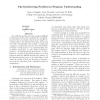Free Online Productivity Tools
i2Speak
i2Symbol
i2OCR
iTex2Img
iWeb2Print
iWeb2Shot
i2Type
iPdf2Split
iPdf2Merge
i2Bopomofo
i2Arabic
i2Style
i2Image
i2PDF
iLatex2Rtf
Sci2ools
WCRE
1995
IEEE
1995
IEEE
The Interleaving Problem in Program Understanding
One of the factors that can make a program di cult to understand is that code responsible for accomplishing more than one purpose may be woven together in a single section. We call this interleaving, and it may arise either intentionally { for example, in optimizing a program, a programmer may use some intermediate result for several purposes { or unintentionally, due to patches, quick xes, or other hasty maintenance practices. To understand this phenomenon, we have looked at a variety of interleaving instances in actual programs and have distilled characteristic features. If the characterization proves to be robust then it will enable the design of tools for detection of interleavings and the extraction of the individual strands of computation.1
| Added | 26 Aug 2010 |
| Updated | 26 Aug 2010 |
| Type | Conference |
| Year | 1995 |
| Where | WCRE |
| Authors | Spencer Rugaber, Kurt Stirewalt, Linda M. Wills |
Comments (0)

